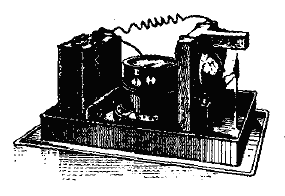Image: Popovs first receiver
Description: One of the first radio receivers, a simple device that rang a bell when a radio signal was received, built by Russian scientist Alexander Stepanovich Popov in 1895. Built as a lightning detector, to warn of thunderstorms by registering the radio pulses of lightning strikes, Popov demonstrated it before the Russian Physical-Chemical Society in St. Petersburg on 7 May 1895, receiving signals from a spark-gap radio transmitter. In Eastern Europe Popov is regarded as the first person to communicate by radio, and May 7 is celebrated as "Radio Day". It used a primitive radio wave detector called a coherer, invented in 1890 by Edouard Branly consisting of a glass tube with metal filings between two electrodes. The coherer was connected to a wire antenna, and also a circuit with a battery (left) and a relay (cylinder, center). When a radio signal from the antenna arrived at the coherer's electrodes, the metal filings became conductive. The current from the battery flowed through the coherer and energized the relay, closing its contacts, and applying the current from the battery to the electromagnet of the electric bell (right) which pulled its arm over to give the bell a tap. To restore the coherer to its receptive state, the filings needed to be disturbed by tapping it, so when the bell arm sprang back it tapped the coherer, automatically resetting it.
Title: Popovs first receiver
Credit: Retrieved 11 November 2013 from (author name redacted) Did Alexandr Popov Invent Radio? NSA Technical Journal, US National Security Agency, Bethesda, MD, Vol. 5, No. 1, January 1960, p. 37 on US National Security Agency website
Author: Unknown
Usage Terms: Public domain
License: Public domain
Attribution Required?: No
Image usage
The following 2 pages link to this image:


